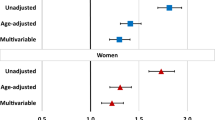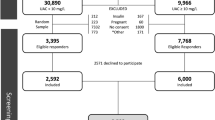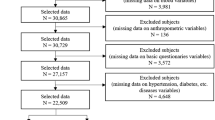Abstract
Background:
The majority of the studies have focused on the effect of general and central fat on coronary risk, neglecting the potential role of peripheral body fat.
Objective:
To assess the effect of surrogate measures for general, central and peripheral body fat on the occurrence of non-fatal acute myocardial infarction (AMI).
Methods:
Population-based case–control study; cases were patients aged ⩾40 years consecutively hospitalized with an incident AMI (n=653), and controls were community participants without previous AMI, selected randomly from the hospitals’ catchment area population (n=1713). Body mass index (BMI), waist circumference (WC), hip circumference and a skinfolds composite index to estimate the proportion of peripheral subcutaneous fat in the arms were ascertained. Associations were summarized with odds ratios (OR) and 95% confidence intervals (95% CI), obtained from unconditional logistic regression with adjustment for the main confounders.
Results:
WC, and in particular waist-to-hip ratio (WHR), had strong direct associations with AMI risk. Peripheral subcutaneous fat was inversely associated with AMI in women, but directly in men. Using principal component analysis, three uncorrelated factors were identified representing different patterns of fat distribution: (1) generalized fat, with high BMI and high WC; (2) central fat, with high WC and WHR; and (3) peripheral subcutaneous fat. The first factor showed no significant association with AMI, but the second factor increased AMI risk in each sex (upper vs lower fourth: OR 12.2, 95% CI 5.34–27.9 in women; OR 25.0, 95% CI 14.0–44.7 in men). In contrast, the third factor was inversely associated with AMI in women (upper vs lower fourth: OR 0.59, 95% CI 0.36–0.96) and directly associated in men (OR 2.45, 95% CI 1.69–3.55; P-value for sex interaction<0.001).
Conclusions:
Central fat was associated with increased risk of AMI in women and men, while the peripheral subcutaneous fat index predicted a lower risk of AMI in women and a higher risk in men.
This is a preview of subscription content, access via your institution
Access options
Subscribe to this journal
Receive 12 print issues and online access
$259.00 per year
only $21.58 per issue
Buy this article
- Purchase on Springer Link
- Instant access to full article PDF
Prices may be subject to local taxes which are calculated during checkout
Similar content being viewed by others
References
Poirier P, Giles TD, Bray GA, Hong Y, Stern JS, Pi-Sunyer FX et al. Obesity and cardiovascular disease: pathophysiology, evaluation, and effect of weight loss: an update of the 1997 American heart association scientific statement on obesity and heart disease from the obesity committee of the council on nutrition, physical activity, and metabolism. Circulation 2006; 113: 898–918.
Wilson PW, D’Agostino RB, Sullivan L, Parise H, Kannel WB . Overweight and obesity as determinants of cardiovascular risk: the Framingham experience. Arch Intern Med 2002; 162: 1867–1872.
Dagenais GR, Yi Q, Mann JF, Bosch J, Pogue J, Yusuf S . Prognostic impact of body weight and abdominal obesity in women and men with cardiovascular disease. Am Heart J 2005; 149: 54–60.
Romero-Corral A, Montori VM, Somers VK, Korinek J, Thomas RJ, Allison TG et al. Association of bodyweight with total mortality and with cardiovascular events in coronary artery disease: a systematic review of cohort studies. Lancet 2006; 368: 666–678.
de Koning L, Merchant AT, Pogue J, Anand SS . Waist circumference and waist-to-hip ratio as predictors of cardiovascular events: meta-regression analysis of prospective studies. Eur Heart J 2007; 28: 850–856.
Yang L, Kuper H, Weiderpass E . Anthropometric characteristics as predictors of coronary heart disease in women. J Intern Med 2008; 264: 39–49.
See R, Abdullah SM, McGuire DK, Khera A, Patel MJ, Lindsey JB et al. The association of differing measures of overweight and obesity with prevalent atherosclerosis: the Dallas heart study. J Am Coll Cardiol 2007; 50: 752–759.
Yusuf S, Hawken S, Ounpuu S, Bautista L, Franzosi MG, Commerford P et al. Obesity and the risk of myocardial infarction in 27 000 participants from 52 countries: a case-control study. Lancet 2005; 366: 1640–1649.
Canoy D, Boekholdt SM, Wareham N, Luben R, Welch A, Bingham S et al. Body fat distribution and risk of coronary heart disease in men and women in the European prospective investigation into cancer and nutrition in Norfolk cohort: a population-based prospective study. Circulation 2007; 116: 2933–2943.
Despres JP, Arsenault BJ, Cote M, Cartier A, Lemieux I . Abdominal obesity: the cholesterol of the 21st century? Can J Cardiol 2008; 24 (Suppl D): 7D–12D.
Zalesin KC, Franklin BA, Miller WM, Peterson ED, McCullough PA . Impact of obesity on cardiovascular disease. Endocrinol Metab Clin North Am 2008; 37: 663–684, ix.
Phillips LK, Prins JB . The link between abdominal obesity and the metabolic syndrome. Curr Hypertens Rep 2008; 10: 156–164.
Ritchie SA, Connell JM . The link between abdominal obesity, metabolic syndrome and cardiovascular disease. Nutr Metab Cardiovasc Dis 2007; 17: 319–326.
Ness-Abramof R, Apovian CM . Waist circumference measurement in clinical practice. Nutr Clin Pract 2008; 23: 397–404.
Williams MJ, Hunter GR, Kekes-Szabo T, Snyder S, Treuth MS . Regional fat distribution in women and risk of cardiovascular disease. Am J Clin Nutr 1997; 65: 855–860.
Tankó LB, Bagger YZ, Alexandersen P, Larsen PJ, Christiansen C . Peripheral adiposity exhibits an independent dominant antiatherogenic effect in elderly women. Circulation 2003; 107: 1626–1631.
Seidell JC, Perusse L, Despres JP, Bouchard C . Waist and hip circumferences have independent and opposite effects on cardiovascular disease risk factors: the Quebec family study. Am J Clin Nutr 2001; 74: 315–321.
Tatsukawa M, Kurokawa M, Tamari Y, Yoshimatsu H, Sakata T . Regional fat deposition in the legs is useful as a presumptive marker of antiatherogenesity in Japanese. Proc Soc Exp Biol Med 2000; 223: 156–162.
Ferreira I, Snijder MB, Twisk JW, van Mechelen W, Kemper HC, Seidell JC et al. Central fat mass versus peripheral fat and lean mass: opposite (adverse versus favorable) associations with arterial stiffness? The Amsterdam growth and health longitudinal study. J Clin Endocrinol Metab 2004; 89: 2632–2639.
Frayn KN . Adipose tissue as a buffer for daily lipid flux. Diabetologia 2002; 45: 1201–1210.
Berg AH, Combs TP, Scherer PE . ACRP30/adiponectin: an adipokine regulating glucose and lipid metabolism. Trends Endocrinol Metab 2002; 13: 84–89.
Ross R, Shaw KD, Rissanen J, Martel Y, de Guise J, Avruch L . Sex differences in lean and adipose tissue distribution by magnetic resonance imaging: anthropometric relationships. Am J Clin Nutr 1994; 59: 1277–1285.
Alpert JS, Thygesen K, Antman E, Bassand JP . Myocardial infarction redefined-a consensus document of the joint European Society of Cardiology/American College of Cardiology committee for the redefinition of myocardial infarction. J Am Coll Cardiol 2000; 36: 959–969.
Hartge P, Brinton LA, Rosenthal JF, Cahill JI, Hoover RN, Waksberg J . Random digit dialing in selecting a population-based control group. Am J Epidemiol 1984; 120: 825–833.
Ramos E, Lopes C, Barros H . Investigating the effect of nonparticipation using a population-based case-control study on myocardial infarction. Ann Epidemiol 2004; 14: 437–441.
Gibson RS . Principals of Nutritional Assessment. Oxford University Press: New York, 2005.
Expert panel on the identification, evaluation, and treatment of overweight in adults. Clinical guidelines on the identification, evaluation, and treatment of overweight and obesity in adults: executive summary. Am J Clin Nutr 1998; 68: 899–917.
Lopes C . Reproducibility and validity of a semi-quantitative food-frequency questionnaire. In: Diet and Acute Myocardial Infarction: A Population-Based Case-Control Study. [PhD thesis in Portuguese.] University of Porto: Porto, Portugal, 2000, pp 79–115.
Folstein M, Folstein S, McHush R . ‘Mini-mental state’. A practical method for grading the cognitive state of patients for the clinician. J Psychiatr Res 1975; 12: 189–198.
Bartholomew D, Steele F, Moustaki I, Galbraith J . The Analysis and Interpretation of Multivariate Data for Social Scientists. Chapman & Hall/CRC: London, 2002.
Azevedo A, Ramos E, von Hafe P, Barros H . Upper-body adiposity and risk of myocardial infarction. J Cardiovasc Risk 1999; 6: 321–325.
Snijder MB, Dekker JM, Visser M, Bouter LM, Stehouwer CD, Kostense PJ et al. Associations of hip and thigh circumferences independent of waist circumference with the incidence of type 2 diabetes: the Hoorn study. Am J Clin Nutr 2003; 77: 1192–1197.
Snijder MB, Dekker JM, Visser M, Yudkin JS, Stehouwer CD, Bouter LM et al. Larger thigh and hip circumferences are associated with better glucose tolerance: the Hoorn study. Obes Res 2003; 11: 104–111.
Lissner L, Bjorkelund C, Heitmann BL, Seidell JC, Bengtsson C . Larger hip circumference independently predicts health and longevity in a Swedish female cohort. Obes Res 2001; 9: 644–646.
Canoy D . Distribution of body fat and risk of coronary heart disease in men and women. Curr Opin Cardiol 2008; 23: 591–598.
Caserta F, Tchkonia T, Civelek VN, Prentki M, Brown NF, McGarry JD et al. Fat depot origin affects fatty acid handling in cultured rat and human preadipocytes. Am J Physiol Endocrinol Metab 2001; 280: E238–E247.
Van Pelt RE, Evans EM, Schechtman KB, Ehsani AA, Kohrt WM . Contributions of total and regional fat mass to risk for cardiovascular disease in older women. Am J Physiol Endocrinol Metab 2002; 282: E1023–E1028.
Pouliot MC, Despres JP, Lemieux S, Moorjani S, Bouchard C, Tremblay A et al. Waist circumference and abdominal sagittal diameter: best simple anthropometric indexes of abdominal visceral adipose tissue accumulation and related cardiovascular risk in men and women. Am J Cardiol 1994; 73: 460–468.
Lev-Ran A . Human obesity: an evolutionary approach to understanding our bulging waistline. Diabetes Metab Res Rev 2001; 17: 347–362.
Goodpaster BH, Thaete FL, Simoneau JA, Kelley DE . Subcutaneous abdominal fat and thigh muscle composition predict insulin sensitivity independently of visceral fat. Diabetes 1997; 46: 1579–1585.
Sardinha LB, Teixeira PJ, Guedes DP, Going SB, Lohman TG . Subcutaneous central fat is associated with cardiovascular risk factors in men independently of total fatness and fitness. Metabolism 2000; 49: 1379–1385.
Seidell JC, Oosterlee A, Thijssen MA, Burema J, Deurenberg P, Hautvast JG et al. Assessment of intra-abdominal and subcutaneous abdominal fat: relation between anthropometry and computed tomography. Am J Clin Nutr 1987; 45: 7–13.
Acknowledgements
We gratefully acknowledge the Head and Staff of the Cardiology Departments of the four hospitals collaborating in this study: Hospital São João; Hospital Pedro Hispano; Centro Hospitalar Vila Nova de Gaia and Hospital Geral Santo António. This work was funded by grant supports from Fundação para a Ciência e a Tecnologia, Portugal. (POCTI/ESP/42361/2001, POCTI/SAU-ESP/61160/2004, SFRH/BD/31131/2006).
Author information
Authors and Affiliations
Corresponding author
Ethics declarations
Competing interests
The authors declare no conflict of interest.
Rights and permissions
About this article
Cite this article
Oliveira, A., Rodríguez-Artalejo, F., Severo, M. et al. Indices of central and peripheral body fat: association with non-fatal acute myocardial infarction. Int J Obes 34, 733–741 (2010). https://doi.org/10.1038/ijo.2009.281
Received:
Revised:
Accepted:
Published:
Issue Date:
DOI: https://doi.org/10.1038/ijo.2009.281



